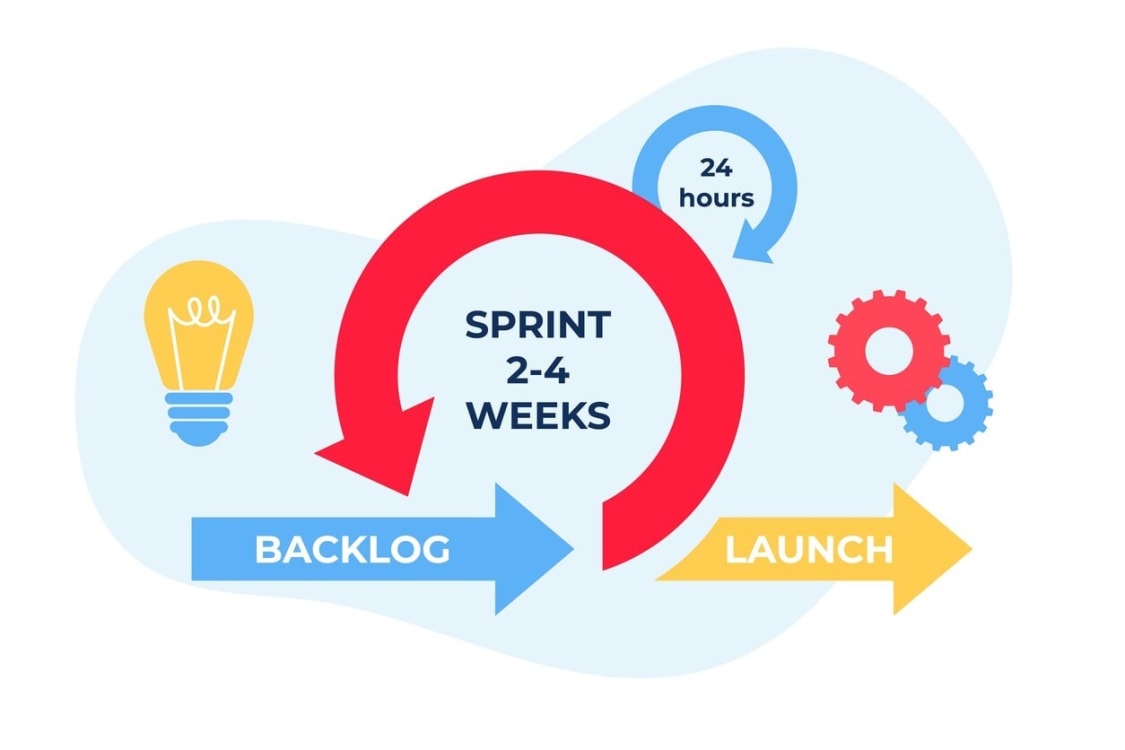Agile is a popular way to manage projects, especially in software development, because it helps teams move faster, work better together, and stay flexible when things change. Instead of tackling everything at once, Agile breaks work into smaller, focused chunks called sprints, making it easier to adapt and keep customers happy.
In this article, we’ll walk through the basics of Agile methodology, its core principles, key practices, and how your team can start using it to work smarter and more efficiently.
Key Takeaways
- Agile methodology is a flexible project management framework characterized by iterative development, customer collaboration, and adaptability, primarily focusing on software development.
- The core values of Agile enhance collaboration and responsiveness, emphasizing individuals and interactions over processes, and prioritize working software and customer collaboration.
- Implementing Agile methodology involves defining a clear project vision, building cross-functional teams, and conducting regular retrospectives to foster continuous improvement and project alignment.
What is Agile Methodology?

Agile methodology is a project management framework that utilizes the agile method. It breaks down projects into dynamic phases known as sprints. Its primary purpose is to improve flexibility, customer satisfaction, and collaboration in software development. Agile methodologies are characterized by:
- Adaptability
- Flexibility
- Customer involvement
- Testing during development
An iterative process with a continuous feedback loop sets Agile apart from traditional software development models, allowing teams to respond promptly to changes. The role of the product owner in Agile is crucial, as they develop the path to the product, including goals and features.
Core Values of Agile Methodology
The Agile Manifesto outlines four fundamental agile values that shape Agile practices, emphasizing collaboration, flexibility, continuous delivery, and responsiveness to changes. These core values guide Agile software development teams, fostering an environment that prioritizes individuals and interactions, working software, customer collaboration, and responsiveness to change.
Individuals and Interactions Over Processes and Tools
Agile project management places significant emphasis on valuing people and their interactions over rigid processes and tools. Agile software development teams thrive on face-to-face communication, which is considered the most effective way to collaborate.
Agile methodologies foster a dynamic and cohesive development process by breaking down silos and promoting common agile methodologies and dynamic systems development method cross-functional teams.
Working Software Over Comprehensive Documentation
In Agile methodologies, the delivery of functional software is prioritized over extensive documentation. Agile development methodology focuses on creating working software that provides immediate value to users, allowing for quick responses to feedback and changing requirements, including feature-driven development FDD.
This approach ensures that Agile teams can maintain momentum and deliver valuable products efficiently.
Customer Collaboration Over Contract Negotiation
Agile project management emphasizes customer collaboration as a key component for successful project outcomes. Agile teams prioritize continuous engagement and feedback from customers over strict contract negotiation, ensuring that the development process remains aligned with customer needs and expectations.
Responding to Change Over Following a Plan
Agile methodologies promote responding to change rather than rigidly following a plan. Agile project management allows teams to quickly shift strategies and workflows in response to evolving project needs. This adaptive approach ensures that Agile teams can stay aligned with the current environment and project goals.
Key Principles of Agile Development

The Agile manifesto is guided by 12 essential principles aimed at fostering effective software development and agile concepts. These principles enhance customer satisfaction by facilitating regular feedback and engagement throughout the project.
The emphasis on continuous delivery, welcoming changing requirements, and sustainable development sets the groundwork for a successful agile mindset in Agile teams.
Early and Continuous Delivery
Early and continuous delivery of valuable software is a cornerstone of Agile project management. Agile teams strive to deliver working products frequently, ideally within weeks rather than months, ensuring that they can respond quickly to user feedback and changing requirements.
Regular retrospectives allow teams to identify strengths and areas for improvement, fostering an environment of continuous improvement and team performance enhancement.
Reflecting on their processes in retrospectives allows Agile teams to refine their adaptive software development practices continuously, leading to more efficient project execution. This iterative approach improves software quality and enhances customer and team member satisfaction.
Welcoming Changing Requirements
Agile methodologies are designed to welcome and prioritize changing requirements, even late in the development process. Reviewing and adjusting plans between sprints, along with maintaining open communication with developers, allows Agile teams to effectively respond to evolving project needs and ensure the final product meets customer expectations.
Sustainable Development
Sustainable development in Agile promotes maintaining a steady work pace to avoid team exhaustion and burnout. Ensuring a balanced workload in Agile practices helps sustain team morale and productivity, leading to better health and job satisfaction for team members.
This approach ensures that Agile teams can maintain high performance over the long term.
The Agile Process: Step-by-Step

The Agile process is a structured framework that includes various steps dedicated to improving the software development process. These steps are:
- Requirement gathering’
- Sprint planning
- Development
- Testing
- Deployment
- Maintenance
Each step plays a crucial role in delivering high-quality software through agile processes. Following these steps helps Agile teams ensure continuous improvement and alignment with project goals.
Requirement Gathering
Requirement gathering is the initial step in Agile project management, where customer requirements are collected and prioritized to guide the project’s direction. During sprint planning, a list of backlog items is created, focusing on the most critical and prioritized requirements to ensure that the development efforts align with customer needs.
Sprint Planning
Sprint planning is a crucial event in Agile methodologies, particularly in Scrum, where specific tasks for the sprint are planned. This process outlines the deliverables for the sprint, ensuring that Agile teams have clear goals and expectations for each iteration.
Typically, Agile projects include 3 to 5 sprints, each focusing on a set of prioritized tasks.
Development Phase
The development phase in agile software development methodology emphasizes a rapid and iterative approach to software development. Frequent and rapid iterations are crucial in achieving timely advancements and adapting to changes in project requirements. This iterative development process enhances not only the speed of delivery but also ensures the quality of the developed software through continuous improvements.
Testing and Quality Assurance
Testing is a critical component of Agile development, ensuring that the software meets quality standards and customer expectations. In Agile methodologies, testing involves:
- Occurring concurrently with programming
- Using automation to reduce the burden of repetitive tests
- Increasing confidence in the software’s reliability
Sprint reviews play a vital role in the Agile process, ensuring alignment with delivery and helping identify bugs or inaccuracies in the software. Moreover, machine learning and AI technologies can improve testing processes by enabling adaptable and self-healing tests, further enhancing the quality assurance in Agile development.
Deployment and Integration
In the Agile process, deployment means releasing finished software to users so they can start using it right away. Agile focuses on delivering valuable, working software early and often, ensuring users get access to new features and improvements as quickly as possible.
Integration with existing systems is crucial for ensuring that the new software functions seamlessly within the current infrastructure.
Maintenance and Support
Ongoing maintenance in Agile is crucial for adapting to changing user needs and feedback. Focusing on user feedback ensures that Agile teams keep the software relevant and user-centric.
Maintaining a sustainable working pace involves a speed that prevents team burnout and ensures long-term project success.
Popular Agile Frameworks

Agile project management encompasses various project management frameworks, each bringing unique practices catering to specific project needs. Popular Agile frameworks include Scrum, Kanban, and Extreme Programming (XP), which offer distinct approaches to managing software development projects.
These frameworks enhance collaboration, flexibility, and continuous improvement within agile teams using agile tools and an adaptive project framework APF.
Scrum
Scrum is an Agile framework that divides projects into sprints, each typically lasting two to four weeks. The key roles in Scrum include:
- Product Owner: Represents the business in development activities, ensuring that the team’s work aligns with customer needs and priorities.
- Scrum Master: Responsible for clearing obstacles for team members, facilitating meetings, and ensuring that the Scrum framework is followed.
- Developers: Responsible for building and delivering the product. They turn ideas and requirements into working software by writing code, testing features, fixing bugs, and collaborating closely with the Product Owner and Scrum Master.
Daily Scrum meetings, also known as stand-ups, are a cornerstone of the Scrum methodology, promoting transparency and collaboration among team members. A Scrum board is used to visualize the team’s progress, making it easy to track the status of tasks and identify any roadblocks.
However, a common mistake is appointing someone from the development team as the Product Owner, which can lead to distractions and breakdowns in collaboration.
Kanban
Kanban is a visual approach to Agile that uses boards to represent task progress. This method facilitates efficient planning based on time and resources, allowing teams to visualize their workflow and make adjustments to tasks at any time.
Kanban fosters a continuous workflow, helping Agile teams maintain momentum and quickly adapt to changing project requirements.
This is a heading.Extreme Programming (XP)
Extreme Programming (XP) is an Agile framework focused on user-centric development, regular meetings, and quality collaboration. Extreme Programming is based on core values, which include:
- Communication
- Simplicity
- Feedback
- Courage
- Respect
XP practices involve small releases, simple design, customer acceptance tests, and continuous interaction to ensure that the software meets user needs and maintains high quality.
Benefits of Agile Methodology

Agile methodology offers numerous benefits, including flexibility, enhanced collaboration, and faster time-to-market. Agile practices encourage rapid responses to change, allowing teams to stay aligned with customer needs.
An environment of teamwork and continuous improvement in Agile methodologies leads to efficient project delivery and higher customer satisfaction.
Flexibility and Adaptability
One of the core strengths of Agile project management is its flexibility and adaptability. Agile methodologies emphasize welcoming changing requirements, even late in the development process, which enhances the project’s relevance and competitive edge in evolutionary project management.
This responsiveness allows teams to adjust strategies quickly based on new information and evolving customer feedback needs.
Enhanced Collaboration
Agile methodologies foster enhanced collaboration through:
- Effective communication and teamwork
- Emphasis on face-to-face interactions, promoting open communication and shared decision-making among team members
- Daily meetings and frequent interactions to keep team members aligned and focused on common goals, utilizing the most common agile methodologies.
These practices enhance overall project success.
Faster Time-to-Market
Agile teams operate within short cycles known as sprints, facilitating quick delivery and adjustments based on feedback. This iterative approach allows businesses to deliver functional software incrementally, enabling quicker responses to user needs and market changes. An agile team enhances this process by ensuring collaboration and adaptability within the agile software development lifecycle and the agile model.
The result is a faster time-to-market for new features and products, enhancing customer satisfaction and competitive advantage.
Challenges of Agile Methodology
Despite its benefits, Agile methodology presents several challenges, including scope creep, team coordination issues, and resource management difficulties. Agile’s emphasis on flexibility can sometimes lead to uncontrolled scope changes and misunderstandings about project goals.
Effective management and communication practices are essential to mitigate these challenges and ensure successful agile project delivery.
Scope Creep
Scope creep is a common challenge in Agile projects, often resulting from unmanaged changes to requirements. While flexibility is a core principle of Agile, it can lead to scope creep if changes are not carefully managed and controlled.
Balancing the need for adaptability with strict management of changes is essential to prevent uncontrolled scope expansion in Agile projects.
Team Coordination
Effective team coordination is crucial for the success of Agile projects. Agile teams, especially those that are geographically dispersed, rely on effective communication tools and practices to facilitate collaboration. Good communication practices not only improve team dynamics but also enhance overall project success by addressing issues promptly and maintaining alignment towards common goals.
Resource Management
In Agile, balancing resources and workload is crucial to maintain sustainable development practices. Agile’s flexibility and adaptability help teams respond to changes in resource availability and project requirements. Building cross-functional teams with diverse skills is fundamental for better resource management and collaboration in Agile projects.
Regular retrospectives help teams reflect on their processes and make necessary adjustments for improved resource allocation and workload management.
Implementing Agile Methodology
Implement agile methodology involves several key steps, including:
- Defining project vision.
- Building cross-functional teams.
- Conducting regular retrospectives.
Regular retrospectives allow the team to adapt their processes and continuously improve.
Define Project Vision and Goals
A clear project vision is crucial in Agile project management as it sets the direction and purpose for the project. A project vision statement should succinctly capture the project’s primary purpose and aspirations, aligning the team towards common objectives.
Clearly defining objectives and desired outcomes ensures that all team efforts align with the overarching project goals.
Build Cross-Functional Teams
Building cross-functional teams is essential for Agile project management. These teams combine diverse skill sets, enabling quicker problem-solving and creativity. Agile methodologies encourage breaking down project silos to foster collaboration among diverse team members, enhancing the overall effectiveness of project execution.
Conduct Regular Retrospectives
Conducting regular retrospectives is a critical practice in Agile development methodology. The purpose of a sprint retrospective is to review and improve from the previous sprint, identifying learnings and areas for improvement for future tasks.
This continuous improvement process helps Agile teams refine their practices and enhance their project delivery.
Top Agile Certifications
Certifications play a crucial role in helping professionals gain expertise in Agile methodologies. Top Agile certifications include Certified ScrumMaster (CSM), SAFe® Agilist Certification, and ICAgile Certified Professional (ICP). These certifications validate knowledge and skills in Agile practices, making professionals valuable assets to Agile teams and organizations.
Certified ScrumMaster (CSM)
The Certified ScrumMaster (CSM) certification validates a person’s knowledge and expertise in Scrum practices and principles. Scrum is an Agile framework focused on small teams working in sprints with defined roles.
The CSM certification helps professionals demonstrate their understanding of Scrum, making them valuable assets to Agile teams.
SAFe® Agilist Certification
The SAFe® Agilist Certification prepares professionals to implement the Scaled Agile Framework effectively across large organizations. This certification supports professionals in scaling Agile practices across large enterprises, enabling them to lead large projects and Agile Release Trains (ARTs).
The live instructor-led online training in the Leading SAFe® 6.0 Training lasts for 16 hours.
ICAgile Certified Professional (ICP)
The ICAgile Certified Professional (ICP) certification is a broad certification covering various Agile practices and frameworks. The ICP-ACC certification training course focuses on collaboration and conflict-resolution tools, alignment with business goals, and continuous improvement.
The ICP-ACC certification training course covers a variety of skills. These include:
- Leadership
- Conflict management
- The Scrum framework
- Team development models
- Release management
- Enterprise Agile coaching
Future Trends in Agile Methodology
Agile methodology continues to evolve, with future trends including AI integration, DevOps convergence, and expansion beyond IT. Selecting the appropriate Agile framework for the team is a critical priority when implementing Agile methodology, considering factors like team size, project requirements, and team experience with methodologies.
These trends reflect the ongoing adaptation and innovation within Agile practices.
AI Integration
Artificial intelligence (AI) is being integrated with Agile methodologies to streamline processes and improve decision-making efficiency. AI tools can analyze project data to provide insights and predictive analytics that help teams make informed choices.
The potential impact of AI on Agile methodologies includes increased adaptability, better resource management, and enhanced collaboration among team members.
DevOps Convergence
There is a noticeable trend of integrating Agile methodologies with DevOps to create a continuous delivery pipeline. Combining Agile practices with DevOps supports continuous integration and delivery, streamlining development processes and enhancing overall productivity.
This convergence enables teams to deliver developing software in a more efficient and timely manner.
Expansion Beyond IT
Agile methodology has expanded beyond IT into various sectors, reflecting its flexibility and adaptability. Key sectors where Agile principles are applied include finance, healthcare, and marketing.
Agile can also be applied in non-software products, general project management, IT infrastructure, and learning engineering.
Summary
Agile methodology offers a dynamic approach to project management, emphasizing flexibility, collaboration, and continuous improvement. By understanding and implementing the core values, principles, and steps of Agile, teams can enhance their productivity and deliver valuable software efficiently. Embracing Agile practices not only improves project outcomes but also fosters a culture of innovation and responsiveness. As Agile continues to evolve, integrating new trends and technologies will further enhance its impact across various sectors.
The key values of Agile methodology prioritize individuals and interactions, working software, customer collaboration, and adaptability to change over rigid processes, documentation, contract negotiations, and fixed plans. This emphasis fosters a dynamic and responsive approach to project management.
Agile methodologies effectively embrace changing requirements by prioritizing flexibility and open communication, allowing teams to adapt to evolving project needs even late in the development process. This responsive approach ensures that the final product aligns closely with stakeholder expectations.
The most popular Agile frameworks are Scrum, Kanban, and Extreme Programming (XP), each designed to improve collaboration and adaptability in project management. These frameworks provide distinct practices tailored to meet varied project requirements.
Agile methodology provides key benefits such as flexibility, improved collaboration, and expedited time-to-market. Its focus on rapid adaptation to changes ensures that teams remain attuned to customer needs, resulting in efficient delivery of valuable software.
AI integration with Agile methodologies enhances decision-making and streamlines processes by analyzing project data for insights and predictive analytics. This allows teams to make informed choices, ultimately improving collaboration and resource management.





